A Case of Severe Progres sion of HIV-1 Meningoencephalitis and Lues Secundaria
Authors:
M. Zlámal 1; P. Smejkal 1; T. Tyll 2; R. Havlíček 3; P. Navrátil 4; M. Holub 1
Authors‘ workplace:
Klinika infekčních nemocí 1. LF UK a ÚVN Praha
1; Klinika anesteziologie, resuscitace a intenzivní medicíny 1. LF UK a ÚVN Praha
2; Neurologické oddělení, ÚVN Praha
3; Psychiatrické oddělení, ÚVN Praha
4
Published in:
Cesk Slov Neurol N 2016; 79/112(6): 703-706
Category:
Case Report
Overview
Acute meningoencephalitis manifesting itself within weeks to months after infection with the human immunodeficiency virus (HIV) and may have severe course. We present an uncommon case of a 40-year-old male newly diagnosed with acute HIV infection and secondary syphilis after he was examined for fever and hepatorenal failure. Two days after the patient was informed about his HIV and syphilis diagnosis he developed hyperventilation, seizures and coma for which he had to be intubated. The reaction raised suspicion of an ongoing acute neuroinfection. Subsequent cerebrospinal fluid analysis revealed mild lymphocytic pleocytosis and high level of HIV-1 RNA leading to diagnosis of HIV-1 meningoencephalitis. Absence of intrathecal synthesis of antitreponemal antibodies excluded neurosyphilis. Treatment with a combination of antiretroviral therapy, neurological and psychiatric medication and supportive psychotherapy led to significant improvement of patient’s neuropsychological condition. In addition, therapy with betalactam antibiotics cured syphilis and resulted in normalization of liver and renal functions. To our knowledge, no case study of severe HIV-1 meningoencephalitis with concomitant complicated secondary syphilis with hepatorenal failure has thus far been reported in the literature.
Key words:
HIV-1 meningoencephalitis – secondary syphilis – life-threatening affective reaction – hepatorenal failure – combination antiretroviral therapy – multidisciplinary care
The authors declare they have no potential conflicts of interest concerning drugs, products, or services used in the study.
The Editorial Board declares that the manuscript met the ICMJE “uniform requirements” for biomedical papers.
Sources
1. Staňková M. Infekce vyvolané retroviry. In: Beneš J a kol (eds). Infekční lékařství. 1. vyd. Praha: Galén 2009 : 147 – 61.
2. Černý R, Machala L. Neurologické komplikace HIV/ AIDS. 1. vyd. Praha: Karolinum 2007.
3. del Saz SV, Sued O, Falcó V, et al. Acute meningoencephalitis due to human immunodeficiency virus type 1 infection in 13 patients: clinical description and follow-up. J Neurovirol 2008;14(6):474 – 9. doi: 10.1080/ 13550280802195367.
4. Centers for Disease Control and Prevention (CDC). Symptomatic early neurosyphilis among HIV-positive men who have sex with men – four cities, United States, January 2002 – June 2004. MMWR Morb Mortal Wkly Rep 2007;56(25):625 – 8.
5. Orlando M, Burnam M, Beckman R, et al. Re-estimating the prevalence of psychiatric disorders in a nationally representative sample of persons receiving care for HIV: Results from the HIV Cost and Services Utilization Study. Int J Methods Psychiatr Res 2002;11(2):75 – 82. doi: 10.1002/ mpr.125.
6. Lawrence DM, Major EO. HIV-1 and the brain: connections between HIV-1-associated dementia, neuropathology and neuroimunology. Microbes Infect 2002;4(3):301 – 8.
7. Clifford DB. AIDS dementia. Med Clin North Am 2002;86(3):537 – 50.
8. Letendre SL, van den Brande G, Hermes A, et al. Lopinavir with ritonavir reduces the HIV RNA level in cerebrospinal fluid. Clin Infect Dis 2007;45(11):1511 – 7.
9. Snopková S, Rozsypal H, Aster V, et al. Doporučený postup péče o dospělé infikované HIV a postexpoziční profylaxe infekce HIV. [online]. Dostupné z URL: http:/ / www.infekce.cz/ DoporART16.htm.
10. Brooks BR, Adams RD. Cerebrospinal fluid acid-base and lactate changes after seizures inunanesthetized man. I. Idiopathic seizures. Neurology 1975;25(10):935 – 42.
11. Němeček V, Malý M, Zákoucká H. Trendy vývoje a výskyt HIV/ AIDS v ČR v roce 2015. [online]. Dostupné z URL: http:/ / www.szu.cz/ tema/ prevence/ zprava-o-vyskytu-a-sireni-hiv-aids-za-rok-2015.
12. ÚZIS ČR. Infekční nemoci v České republice 2010–2012. Aktuální informace 2013(33):1 – 11.
13. Salavec M, Boštíková V, Vaňásková Z, et al. Treponema pallidum, subspecies pallidum – původce neurosyphilis. Epidemiol Mikrobiol Imunol 2013;62(3):91 – 9.
14. Harding AS, Ghanem KG. The performance of cerebrospinal fluid treponemal-specific antibody tests in neurosyphilis: a systematic review. Sex Transm Dis 2012;39(4):291 – 7. doi: 10.1097/ OLQ.0b013e31824c0e62.
15. Janier M, Hegyi V, Dupin N, et al. 2014 European guideline on the management of syphilis. J Eur Acad Dermatol Venereol 2014;28(12):1581 – 93. doi: 10.1111/ jdv.12734.
16. Crum-Cianflone N, Weekes J, Bavaro M. Syphilitic hepatitis among HIV-infected patients. Int J STD AIDS 2009;20(4):278 – 84. doi: 10.1258/ ijsa.2008.008324.
17. Yoshikawa K, Aida Y, Seki N, et al. Early syphilitic hepatitis concomitant with nephrotic syndrome followed by acute kidney injury. Clin J Gastroenterol 2014;7(4):349 – 54. doi: 10.1007/ s12328-014-0499-x.
Labels
Paediatric neurology Neurosurgery NeurologyArticle was published in
Czech and Slovak Neurology and Neurosurgery

2016 Issue 6
Most read in this issue
- Anterior Cervical Osteophytes Causing Dysphagia and Dyspnea – Two Case Reports
- Depression in Selected Neurological Disorders
- Autoimmune Encephalitis – Case Reports
- Surgical Treatment of Extensive Fibrous Dysplasia in the Craniofacial Region – a Case Report
